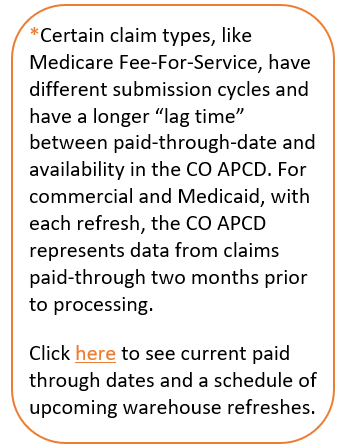Each month health insurance payers submit millions of medical, professional, pharmacy, and dental claims for inclusion in the Colorado All Payer Claims Database (CO APCD). Work to ensure that this data coming into the CO APCD is the most credible and highest quality begins before the files are sent. CIVHC and data manager, Human Services Research Institute (HSRI) and NORC at the University of Chicago, work with payers prior to submission to make sure they understand the requirements and ensure the process is as smooth as possible.
Payers create their submission files based on the most current Data Submission Guide (DSG) provided by CIVHC. The DSG outlines field by field what information the claims files should contain and in what format. In order for claims to pass validation and move into more extensive quality checks, all submitters must follow the instructions in the current DSG. Seemingly minor errors, like incorrect file names, can cause claims to fail validation.
Files are securely submitted through HSRI’s submission portal and into NORC’s secure Data Enclave where they are run through an automated validation process. Currently, there is a library of over 300 validation tests that are performed on new submissions to the CO APCD and all submissions must pass before they can progress into further quality checks.
The submission portal lets submitters know when claims are received and when validation begins, which usually happens within minutes but can take up to 24 hours. Upon completion of validation, submitters are notified as to whether there are issues with their submission or if the claims passed the tests. Detailed information about any submission issues are available in the online portal so submitters can investigate the results of the validation and make any necessary adjustments prior to resubmitting the data.
After the initial submission validation comes more finely tuned quality checks, designed to make sure the data is accurate and actionable. HSRI analysts compare the newly submitted data to historic submission benchmarks, and look to ensure things like monthly payments per member, eligibility, total allowed amounts, and other measures compare reasonably with past submissions. These quality checks allow analysts to see if there are any unexpected anomalies that may result from data submission errors. Once all validation and quality assurance concerns have been addressed, the claims are processed and move into the CO APCD data warehouse.
Refreshing the Data Warehouse
While payers submit claims for processing each month, the data in the CO APCD is  refreshed and processed every other month.* The refresh process not only incorporates the two most recent months of claims but also reprocesses the entire CO APCD to continually improve the quality of the data. Reprocessing the entire database is important because it includes historic claims that weren’t paid during the last submission cycle, and can include resubmissions to correct identified concerns. In essence, the bi-monthly refreshes create a wholly new, and improved, CO APCD every time.
refreshed and processed every other month.* The refresh process not only incorporates the two most recent months of claims but also reprocesses the entire CO APCD to continually improve the quality of the data. Reprocessing the entire database is important because it includes historic claims that weren’t paid during the last submission cycle, and can include resubmissions to correct identified concerns. In essence, the bi-monthly refreshes create a wholly new, and improved, CO APCD every time.
It is worth keeping in mind that while refreshes ensure that the CO APCD is continually being enhanced, it also means that data sets and analytics based on the database are not 100% replicable in the future. Each output of the CO APCD during a specific two-month refresh span incorporates different data than the next, and it is possible that a data set or analysis with the same data elements and methodology in the future may show slightly different results.
*Certain claim types, like Medicare Fee-For-Service, have different submission cycles and have a longer “lag time” between paid-through-date and availability in the CO APCD. For commercial and Medicaid, with each refresh, the CO APCD represents data from claims paid-through two months prior to processing. Click here to see current paid through dates and a schedule of upcoming warehouse refreshes.